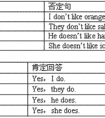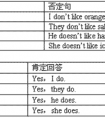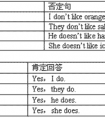按要求改变下列句子。A.WehaveEnglishonWednesdayandSaturday.(就画线部分提问)B. TodayisSunday.(就画线部分提问) C. TodayisApril5th,2005.(就画线部分提问) D.The-六年级英语
d. 与否定副词not合用,构成否定句,例如:
I don't like him. 我不喜欢他。
e. 加强语气,例如:
Do come to the party tomorrow evening. 明天晚上一定来参加晚会。
He did know that. 他的确知道那件事。
考点名称:特殊疑问句
- 特殊疑问句:
以特殊疑问词开头,对句中某一成分提问的句子叫特殊疑问句。
常用的疑问词有:what、who、whose、which、when、where、how、why等。
特殊疑问句往往是就其中的某一成分,进行提问,而且根据情况直接回答,不能用yes或no简单回答。
常见的疑问代词有who, whose, which, what;疑问副词有when, where, why, how。
例:What do you do on Sunday? 你周日的时候干什么?
Which class are you in? 你在哪个班?
Where does Mr. Li live? 李先生住在哪?
Why are you late? 你为什么迟到? 特殊疑问句的构成:
一、 特殊的疑问词。
特殊疑问句要由疑问代词或疑问副词开头,询问的内容不同, 使用的疑问词也不同。
我们学过的疑问词有:
what(询问事物), how much(询问价格),what time (询问时间,尤其是点钟), what kind of(询问种类),why(询问原因),who(询问人), where(询问地点) 等等。如:
—What is this? 这是什么?
—It's a key. 这是一把钥匙。
—How much is it? 这个多少钱?
—It's twenty dollars. 二十美元。
—What kind of movies do you like? 你喜欢哪一类型的电影?
—I like action movies. 我喜欢动作片。
二、特殊的语序。
特殊疑问句由疑问词开头,其构成是“疑问词 + 一般疑问句”。如:
What time is it? 现在几点钟?
Who is your teacher? 谁是你的老师?
三、特殊的答语。
特殊疑问句不能用yes, no来回答,而应根据它所询问的内容直接做出回答才行。如:
— What time is it, please? 请问几点了?
— It's 7:30. 七点半了。
— Where are they? 他们在哪儿?
—They're in the playground. 他们在操场上。
—What's your favorite subject? 你最喜爱的科目是什么?
—English. 英语。
四、 特殊的语调。
一般情况下,特殊疑问句要用降调(↘)来读。如:
Who's ↘that?
How old is↘Jack?特殊疑问句有两种语序:
1.如疑问词作主语或主语的定语,即对主语或主语的定语提问,其语序是陈述句的语序:
Who is singing in the room﹖
whose bike is broken﹖
2.如疑问词作其他成分,即对其他成分提问,其语序是:
特殊疑问词+一般疑问句【特殊疑问词+be/助动词/情态动词+主语+谓语】
What does she like?
What class are you in﹖
Where are you from﹖
What time does he get up every morning﹖
How do you know﹖- 就划线部分提问的基本方法:
小学对特殊疑问句的考查主要采取对划线句子提问的方式,那么在句型转换就划线部分提问的基本方法是:
先根据划线部分词语的意思和句法功能确定用什么疑问词;
然后将原句变为一般疑问句跟在疑问词的后面即可(注意去掉划线部分)。
基本构成:疑问词+一般疑问句
A、对“物”划线用What。
This is an orange. → What is this?
We can see a cat under the desk. → What can you see under the desk?
B、对“地点”划线用Where,如果“地点”作定语时,用Which后跟被修饰的那个名词。
He is under the tree. → Where is he?
Jenny is in the classroom. → Where is Jenny?
C、对“年龄”划线用How old。
Miss Li is twenty-three. → How old is Miss Li?
My sister is five years old. → How old is your sister?
D、对“颜色”划线,用What colour。
Her sweater is red. → What colour is her sweater?
E、对“可数名词的数量”划线用How many +复数名词。
She has one red coat. → How many red coats does she have?
I have six books. → How many books do you have?
F、对“不可数名词的数量”划线用How much+不可数名词。
I want to buy three kilos of meat. →How much meat do you want to buy?
G、对“职业”划线用What。
She is a driver. → What is she?
My father is a farmer. → What is your father?
H、对“星期几”划线用What day。
It's Sunday today. → What day is it today?
I、对“时间”划线用What time。
We go to school at seven in the morning. → What time do you go to school in the morning?
It is five o’clock now. → What time is it?
考点名称:there be 句型
- There be句型:
是英语中常用句型,意思是“有”,表示“人或事物的存在”。
There在此结构中是引导词,已经没有副词“那里”的含义。
There be后面的名词是句子的主语,属倒装结构。常用“There + be+名词+地点/时间状语”的结构。 - There be结构的用法:
A、肯定结构:
There be句型的肯定结构表示“某处存在某物或某人”或“某时发生某事”。
a. There is+单数可数名词/不可数名词+地点/时间状语。
例:There is a cat under the chair. 椅子下面有一只猫。
There is some water in the bottle. 瓶子里有些水。
b. There are +复数名词+地点/时间状语。
例:There are some apples in the basket. 篮子里有一些苹果。
B、否定结构:There be句型的否定结构是在谓语动词be的后面加“not (any)”或“no”.
例:There are no tables in the room. 或者There are not any tables in the room. 房间里没有桌子。
C、疑问结构:There be句型变成疑问式时,要把there和谓语动词be的位置互换。
例:Is there a pen in the schoolbag? 书包里有一支笔吗? - Therebe结构和have的区别与联系:
1.区别点:
there be 意为存在,强调某地有某物,不表示所属关系;
have 表示所有关系, 强调某人或某地有某物,这是其基本用法。如:
There are some trees in front of the house.房前有些树。
Tom has many friends in China.汤姆在中国有许多朋友。
2.相同点:
在表示结构上的含有时,既可以用there be 句型,也可以用have(has) 来表示。如:
中国有许多长河。
There are many long rivers in China.
China has many long rivers.
三月份有多少天?
How many days are there in March?
How many days has March? - There be结构中的be动词的确定:
A、there be 结构中的谓语动词be在人称和数上应与其后的主语保持一致。主语是不可数名词或单数可数名词时用is,是复数时用are。
例:There is a flower in the bottle. 瓶里有一朵花。
There is some money in the purse. 钱包里有些钱。
B、若句子中有几个并列的主语时,be的形式要与离其最近的一个主语在人称和数上保持一致。
例:There is a boy, a girl and two women in the house. 房子里有一个男孩,一个女孩和两个妇女。
There are ten students and a teacher in the office. 办公室里有十个学生和一个教师。
There be结构的句型转换:
A、否定句:
there be的否定式通常在be后加not构成(在口语中be时常与not缩写在一起)。如果句中有some,一般要变成any。 例:
There are some children in the picture.
There aren't any children in the picture.
B、一般疑问句及其答语:
把be提到there前,首字母大写,句末用问号即可。其肯定答语是Yes, there is / are;否定答语为No, there isn't / aren't。 例:
— Are there two cats in the tree?
— Yes, there are. (No, there aren't.)
C、特殊疑问句及其回答
a. 提问句子的主语(包括主语前的修饰语)时,句型一律用“what is+地点介词短语?”(无论主语是单数还是复数都用is)。
例:There are some birds in the tree. → What's in the tree?
b. 就there be后面的地点状语进行提问时,句型用“where is/ are+主语?”
例:There is a car in the street. → Where is the car?
- 最新内容
- 相关内容
- 网友推荐
- 图文推荐
| [家长教育] 孩子为什么会和父母感情疏离? (2019-07-14) |
| [教师分享] 给远方姐姐的一封信 (2018-11-07) |
| [教师分享] 伸缩门 (2018-11-07) |
| [教师分享] 回家乡 (2018-11-07) |
| [教师分享] 是风味也是人间 (2018-11-07) |
| [教师分享] 一句格言的启示 (2018-11-07) |
| [教师分享] 无规矩不成方圆 (2018-11-07) |
| [教师分享] 第十届全国教育名家论坛有感(二) (2018-11-07) |
| [教师分享] 贪玩的小狗 (2018-11-07) |
| [教师分享] 未命名文章 (2018-11-07) |

![—— He'sneartheTVset (电视机).[ ]A.What'stheboydoing?B.Where'stheboy?C.Whoistheboy?-三年级英语](http://www.00-edu.com/d/file/ks/4/1/38/2019-08-19/smalla98d03e1cd1ad5f1eea83d4f5e418fe61566228470.jpg)
![_________ didyou_________?[ ]A. Where; wentB. Where; goC. What; went-六年级英语](http://www.00-edu.com/d/file/ks/4/1/38/2019-08-19/small4cca8e85fae1eda0cb114208d0da83c91566228121.jpg)



